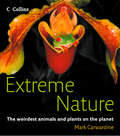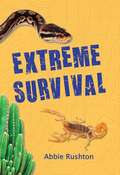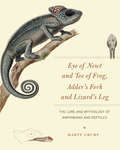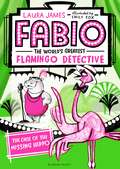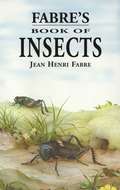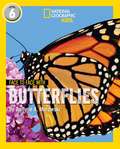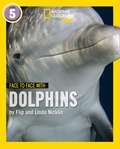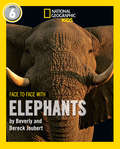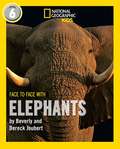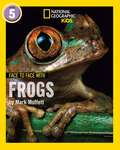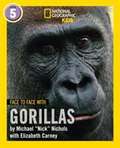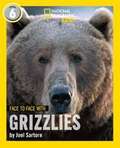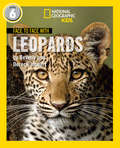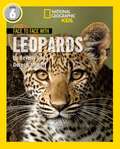- Table View
- List View
Extreme Measures: The Ecological Energetics of Birds and Mammals
by Brian K. McNabAlong with reproduction, balancing energy expenditure with the limits of resource acquisition is essential for both a species and a population to survive. But energy is a limited resource, as we know well, so birds and mammals—the most energy-intensive fauna on the planet—must reduce energy expenditures to maintain this balance, some taking small steps, and others extreme measures. Here Brian K. McNab draws on his over sixty years in the field to provide a comprehensive account of the energetics of birds and mammals, one fully integrated with their natural history. McNab begins with an overview of thermal rates—much of our own energy is spent maintaining our 98.6?F temperature—and explains how the basal rate of metabolism drives energy use, especially in extreme environments. He then explores those variables that interact with the basal rate of metabolism, like body size and scale and environments, highlighting their influence on behavior, distribution, and even reproductive output. Successive chapters take up energy and population dynamics and evolution. A critical central theme that runs through the book is how the energetic needs of birds and mammals come up against rapid environmental change and how this is hastening the pace of extinction.
Extreme Measures: The Ecological Energetics of Birds and Mammals
by Brian K. McNabAlong with reproduction, balancing energy expenditure with the limits of resource acquisition is essential for both a species and a population to survive. But energy is a limited resource, as we know well, so birds and mammals—the most energy-intensive fauna on the planet—must reduce energy expenditures to maintain this balance, some taking small steps, and others extreme measures. Here Brian K. McNab draws on his over sixty years in the field to provide a comprehensive account of the energetics of birds and mammals, one fully integrated with their natural history. McNab begins with an overview of thermal rates—much of our own energy is spent maintaining our 98.6?F temperature—and explains how the basal rate of metabolism drives energy use, especially in extreme environments. He then explores those variables that interact with the basal rate of metabolism, like body size and scale and environments, highlighting their influence on behavior, distribution, and even reproductive output. Successive chapters take up energy and population dynamics and evolution. A critical central theme that runs through the book is how the energetic needs of birds and mammals come up against rapid environmental change and how this is hastening the pace of extinction.
Extreme Measures: The Ecological Energetics of Birds and Mammals
by Brian K. McNabAlong with reproduction, balancing energy expenditure with the limits of resource acquisition is essential for both a species and a population to survive. But energy is a limited resource, as we know well, so birds and mammals—the most energy-intensive fauna on the planet—must reduce energy expenditures to maintain this balance, some taking small steps, and others extreme measures. Here Brian K. McNab draws on his over sixty years in the field to provide a comprehensive account of the energetics of birds and mammals, one fully integrated with their natural history. McNab begins with an overview of thermal rates—much of our own energy is spent maintaining our 98.6?F temperature—and explains how the basal rate of metabolism drives energy use, especially in extreme environments. He then explores those variables that interact with the basal rate of metabolism, like body size and scale and environments, highlighting their influence on behavior, distribution, and even reproductive output. Successive chapters take up energy and population dynamics and evolution. A critical central theme that runs through the book is how the energetic needs of birds and mammals come up against rapid environmental change and how this is hastening the pace of extinction.
Extreme Measures: The Ecological Energetics of Birds and Mammals
by Brian K. McNabAlong with reproduction, balancing energy expenditure with the limits of resource acquisition is essential for both a species and a population to survive. But energy is a limited resource, as we know well, so birds and mammals—the most energy-intensive fauna on the planet—must reduce energy expenditures to maintain this balance, some taking small steps, and others extreme measures. Here Brian K. McNab draws on his over sixty years in the field to provide a comprehensive account of the energetics of birds and mammals, one fully integrated with their natural history. McNab begins with an overview of thermal rates—much of our own energy is spent maintaining our 98.6?F temperature—and explains how the basal rate of metabolism drives energy use, especially in extreme environments. He then explores those variables that interact with the basal rate of metabolism, like body size and scale and environments, highlighting their influence on behavior, distribution, and even reproductive output. Successive chapters take up energy and population dynamics and evolution. A critical central theme that runs through the book is how the energetic needs of birds and mammals come up against rapid environmental change and how this is hastening the pace of extinction.
Extreme Nature (Smithsonian Institution Ser.)
by Mark CarwardineA beautiful and fascinating portrait of the world’s most extreme wildlife, from the sexiest beast to the smelliest plant.
Extremophile Fishes: Ecology, Evolution, and Physiology of Teleosts in Extreme Environments
by Rüdiger Riesch Michael Tobler Martin PlathThis book summarizes the key adaptations enabling extremophile fishes to survive under harsh environmental conditions. It reviews the most recent research on acidic, Antarctic, cave, desert, hypersaline, hypoxic, temporary, and fast-flowing habitats, as well as naturally and anthropogenically toxic waters, while pointing out generalities that are evident across different study systems. Knowledge of the different adaptations that allow fish to cope with stressful environmental conditions furthers our understanding of basic physiological, ecological, and evolutionary principles. In several cases, evidence is provided for how the adaptation to extreme environments promotes the emergence of new species. Furthermore, a link is made to conservation biology, and how human activities have exacerbated existing extreme environments and created new ones. The book concludes with a discussion of major open questions in our understanding of the ecology and evolution of life in extreme environments.
Eye of Newt and Toe of Frog, Adder's Fork and Lizard's Leg: The Lore and Mythology of Amphibians and Reptiles
by Marty CrumpFrogs are worshipped for bringing nourishing rains, but blamed for devastating floods. Turtles are admired for their wisdom and longevity, but ridiculed for their sluggish and cowardly behavior. Snakes are respected for their ability to heal and restore life, but despised as symbols of evil. Lizards are revered as beneficent guardian spirits, but feared as the Devil himself. In this ode to toads and snakes, newts and tuatara, crocodiles and tortoises, herpetologist and science writer Marty Crump explores folklore across the world and throughout time. From creation myths to trickster tales; from associations with fertility and rebirth to fire and rain; and from the use of herps in folk medicines and magic, as food, pets, and gods, to their roles in literature, visual art, music, and dance, Crump reveals both our love and hatred of amphibians and reptiles—and their perceived power. In a world where we keep home terrariums at the same time that we battle invasive cane toads, and where public attitudes often dictate that the cute and cuddly receive conservation priority over the slimy and venomous, she shows how our complex and conflicting perceptions threaten the conservation of these ecologically vital animals. Sumptuously illustrated, Eye of Newt and Toe of Frog, Adder’s Fork and Lizard’s Leg is a beautiful and enthralling brew of natural history and folklore, sobering science and humor, that leaves us with one irrefutable lesson: love herps. Warts, scales, and all.
Eye of Newt and Toe of Frog, Adder's Fork and Lizard's Leg: The Lore and Mythology of Amphibians and Reptiles
by Marty CrumpFrogs are worshipped for bringing nourishing rains, but blamed for devastating floods. Turtles are admired for their wisdom and longevity, but ridiculed for their sluggish and cowardly behavior. Snakes are respected for their ability to heal and restore life, but despised as symbols of evil. Lizards are revered as beneficent guardian spirits, but feared as the Devil himself. In this ode to toads and snakes, newts and tuatara, crocodiles and tortoises, herpetologist and science writer Marty Crump explores folklore across the world and throughout time. From creation myths to trickster tales; from associations with fertility and rebirth to fire and rain; and from the use of herps in folk medicines and magic, as food, pets, and gods, to their roles in literature, visual art, music, and dance, Crump reveals both our love and hatred of amphibians and reptiles—and their perceived power. In a world where we keep home terrariums at the same time that we battle invasive cane toads, and where public attitudes often dictate that the cute and cuddly receive conservation priority over the slimy and venomous, she shows how our complex and conflicting perceptions threaten the conservation of these ecologically vital animals. Sumptuously illustrated, Eye of Newt and Toe of Frog, Adder’s Fork and Lizard’s Leg is a beautiful and enthralling brew of natural history and folklore, sobering science and humor, that leaves us with one irrefutable lesson: love herps. Warts, scales, and all.
Eye of Newt and Toe of Frog, Adder's Fork and Lizard's Leg: The Lore and Mythology of Amphibians and Reptiles
by Marty CrumpFrogs are worshipped for bringing nourishing rains, but blamed for devastating floods. Turtles are admired for their wisdom and longevity, but ridiculed for their sluggish and cowardly behavior. Snakes are respected for their ability to heal and restore life, but despised as symbols of evil. Lizards are revered as beneficent guardian spirits, but feared as the Devil himself. In this ode to toads and snakes, newts and tuatara, crocodiles and tortoises, herpetologist and science writer Marty Crump explores folklore across the world and throughout time. From creation myths to trickster tales; from associations with fertility and rebirth to fire and rain; and from the use of herps in folk medicines and magic, as food, pets, and gods, to their roles in literature, visual art, music, and dance, Crump reveals both our love and hatred of amphibians and reptiles—and their perceived power. In a world where we keep home terrariums at the same time that we battle invasive cane toads, and where public attitudes often dictate that the cute and cuddly receive conservation priority over the slimy and venomous, she shows how our complex and conflicting perceptions threaten the conservation of these ecologically vital animals. Sumptuously illustrated, Eye of Newt and Toe of Frog, Adder’s Fork and Lizard’s Leg is a beautiful and enthralling brew of natural history and folklore, sobering science and humor, that leaves us with one irrefutable lesson: love herps. Warts, scales, and all.
Eye of Newt and Toe of Frog, Adder's Fork and Lizard's Leg: The Lore and Mythology of Amphibians and Reptiles
by Marty CrumpFrogs are worshipped for bringing nourishing rains, but blamed for devastating floods. Turtles are admired for their wisdom and longevity, but ridiculed for their sluggish and cowardly behavior. Snakes are respected for their ability to heal and restore life, but despised as symbols of evil. Lizards are revered as beneficent guardian spirits, but feared as the Devil himself. In this ode to toads and snakes, newts and tuatara, crocodiles and tortoises, herpetologist and science writer Marty Crump explores folklore across the world and throughout time. From creation myths to trickster tales; from associations with fertility and rebirth to fire and rain; and from the use of herps in folk medicines and magic, as food, pets, and gods, to their roles in literature, visual art, music, and dance, Crump reveals both our love and hatred of amphibians and reptiles—and their perceived power. In a world where we keep home terrariums at the same time that we battle invasive cane toads, and where public attitudes often dictate that the cute and cuddly receive conservation priority over the slimy and venomous, she shows how our complex and conflicting perceptions threaten the conservation of these ecologically vital animals. Sumptuously illustrated, Eye of Newt and Toe of Frog, Adder’s Fork and Lizard’s Leg is a beautiful and enthralling brew of natural history and folklore, sobering science and humor, that leaves us with one irrefutable lesson: love herps. Warts, scales, and all.
The Eye of the Sandpiper: Stories from the Living World
by Brandon KeimIn The Eye of the Sandpiper, Brandon Keim pairs cutting-edge science with a deep love of nature, conveying his insights in prose that is both accessible and beautiful. In an elegant, thoughtful tour of nature in the twenty-first century, Keim continues in the tradition of Lewis Thomas, Stephen Jay Gould, and David Quammen, reporting from the frontiers of science while celebrating the natural world’s wonders and posing new questions about our relationship to the rest of life on Earth. The stories in The Eye of the Sandpiper are arranged in four thematic sections. Each addresses nature through a different lens. The first is evolutionary and ecological dynamics, from how patterns form on butterfly wings to the ecological importance of oft-reviled lampreys. The second section explores the inner lives of animals, which science has only recently embraced: empathy in rats, emotions in honeybees, spirituality in chimpanzees. The third section contains stories of people acting on insights both ecological and ethological: nourishing blighted rivers, but also caring for injured pigeons at a hospital for wild birds and demanding legal rights for primates. The fourth section unites ecology and ethology in discussions of ethics: how we should think about and behave toward nature, and the place of wildness in a world in which space for wilderness is shrinking. By appreciating the nonhuman world more fully, Keim writes, "I hope people will also act in ways that nourish rather than impoverish its life—which is, ultimately, the problem that needs to be solved at this Anthropocene moment, with a sixth mass extinction looming, once-common animals becoming rare, and Earth straining to support 7.5 billion people. The solution will come from a love of nature rather than chastisement or lamentation."
Eye of the Shoal: A Fishwatcher's Guide to Life, the Ocean and Everything
by Helen Scales'Scales's genuine appreciation and awe for fish are contagious.' Science'Delightful' New ScientistSeventy per cent of the earth's surface is covered by water. This vast aquatic realm is inhabited by a multitude of strange creatures and reigning supreme among them are the fish.There are giants that live for centuries and thumb-sized tiddlers that survive only weeks; they can be pancake-flat or inflatable balloons; they can shout with colours or hide in plain sight, cheat and dance, remember and say sorry; some rarely budge while others travel the globe restlessly. And yet the mesmerising and complex lives of fish remain largely underrated and unseen, living hidden beneath the waterline, out of sight and out of mind.Helen Scales is our guide on an underwater journey, as we fathom the depths and watch these animals going about the glorious business of being fish. As well as the fish, we meet devoted fishwatchers past and present, from voodoo zombie potion hunters and scientists who taught fish how to walk to nonagenarian explorers of the deep sea.Woven throughout are vignettes of Helen's own aquatic explorations, from eerie nighttime dives with glowing fish and up-close encounters with giant manta rays, to floating in the middle of a swirling shoal being watched by thousands of inquisitive eyes.As well as being a rich and entertaining read, this book will inspire readers to think again about these animals and the seas they inhabit, and to go out and appreciate the wonders of fish, whether through the glass walls of an aquarium or, better still, by gazing into the fishes' wild world and swimming through it.'Engaging and informative' The Economist
Fabio The World's Greatest Flamingo Detective: The Case of the Missing Hippo
by Laura James'Zany ... Even reluctant readers will have a blast' IRISH TIMES In a small town on the banks of Lake Laloozee lives the world's greatest flamingo detective. His name is Fabio. He's not tall or strong, but slight and pink. And he's very, very clever.When Fabio and his giraffe associate Gilbert (terrible at disguises) drop in to the Hotel Royale for a lemonade (pink, naturally), Fabio is persuaded to judge the hotel's talent contest. But when the most promising contestant – Julia the jazz-singing hippopotamus – goes missing, Fabio must put his thinking cap back on and solve the mystery!This new mystery series from Laura James, author of Captain Pug, will have animal lovers and would-be detectives in stitches. Perfect for fans of Claude, Foxy Tales and The Pink Panther!
Fabre's Book of Insects
by Jean Henri FabreHailed by Darwin as "The Homer of Insects," famed French entomologist Jean Henri Fabre (1823–1915) devoted hours of rapt attention to insects while they hunted, built nests, and fed their families. Working in Provence, in barren, sun-scorched fields inhabited by countless wasps and bees, he observed their intricate and fascinating world, recounting their activities in simple, beautifully written essays.This volume, based on translations of Fabre's Souvenirs Entomologiques, blends folklore and mythology with factual explanation. Fabre's absorbing account of the scarab beetle's existence, for example, begins with the ancient Egyptians' symbolic view of this busy creature, eventually leading to a careful discussion of its characteristic method of rolling a carefully sculpted ball of food to its den. Elsewhere, he discusses with infectious enthusiasm the physiologic secrets behind the luminosity of fireflies, the musical talents of the locust, the comfortable home of the field cricket, and the cannibalism of the pious-looking praying mantis, among other topics.These charmingly related stories of insect life are a rare combination of scientific study and literary classic that will delight entomologists, naturalists, and nature lovers alike.
Fabulous Finn: The Brave Police Dog Who Came Back from the Brink
by Dave WardellTHE TOP TEN BESTSELLER: The Inspirational Life of Finn, Britain's Bravest Dog, Winner of the 2017 Daily Mirror Animal Hero of the Year Award and Star of Britain's Got Talent 2019Hertfordshire, October 5th 2016. At around 2 a.m., PC Dave Wardell and his dog, PD Finn, were trying to apprehend a robbery suspect when he turned around and attacked them. Finn was stabbed with a ten-inch-bladed knife, both through his chest, via his armpit and then - the knife bound for Dave - through the top of his head. Finn no doubt saved Dave's life, but the race was on to try and save Finn's.Dave Wardell's heartfelt memoir charts an incredible journey of friendship and loyalty. It is a celebration of the bond between one man and his dog, from when Dave collected Finn from his kennels at just nine months old, all the way through to Finn's recent and hard-earned retirement. The book charts the career of a highly trained, highly decorated dog. In his time on the job Finn tracked offenders of all kinds; found missing children; tackled armed offenders; saved lives. But Finn isn't just a police dog - he's also a cherished family pet and this is his remarkable, life-affirming story.
Face To Face With Butterflies: Level 6 (PDF)
by Darlyne MurawskiNational Geographic Face to Face Readers is a high-interest series of books for confident, independent readers that have been adapted to a Key Stage 2 audience by education experts. The books pair magnificent National Geographic photographs with lively first-person text and fascinating facts about the natural world. Join experienced nature photographer Darlyne Murawski on a journey of transformation and discovery to learn all about these delicate, beautiful creatures. Written in an engaging and fun to read format, the captivating photos and fascinating facts are perfect for encouraging the future explorers and insect scientists of tomorrow! Level 6 readers are ideal for kids who are very confident in reading independently and ready to challenge themselves with a wide variety of sentence structures and writing styles, a range of new technical vocabulary and the need for more complex inference.
Face To Face With Dolphins: Level 5 (PDF)
by Flip Nicklin Linda NicklinNational Geographic Face to Face Readers is a high-interest series of books for confident, independent readers that have been adapted to a Key Stage 2 audience by education experts. The books pair magnificent National Geographic photographs with lively first-person text and fascinating facts about the natural world. Dive deep into the world of Dolphins with experienced nature photographers Flip and Linda Nicklin and learn about these friendly and fascinating mammals. Written in an engaging and fun to read format, the captivating photos and fascinating facts are perfect for encouraging the future explorers and marine biologists of tomorrow! Level 5 readers are ideal for kids who are confident in reading independently and ready for the challenge of varied sentence lengths, some technical vocabulary and increasing inference.
Face to Face with Elephants: Level 6 (National Geographic Readers)
by Beverly Joubert Dereck JoubertNational Geographic Face to Face Readers is a high-interest series of books for confident, independent readers that have been adapted to a Key Stage 2 audience by education experts. The books pair magnificent National Geographic photographs with lively first-person text and fascinating facts about the natural world.
Face To Face With Elephants: Level 6 (National Geographic Readers Ser.)
by Dereck Joubert Beverly JoubertNational Geographic Face to Face Readers is a high-interest series of books for confident, independent readers that have been adapted to a Key Stage 2 audience by education experts. The books pair magnificent National Geographic photographs with lively first-person text and fascinating facts about the natural world. Take a trip to the African bush with experienced nature photographers and get up close and personal with the largest land animals on Earth. Written in an engaging and fun to read format, the captivating photos and fascinating facts are perfect for encouraging the future explorers and researchers of tomorrow! Level 6 readers are ideal for kids who are very confident in reading independently and ready to challenge themselves with a wide variety of sentence structures and writing styles, a range of new technical vocabulary and the need for more complex inference.
FACE TO FACE WITH FROGS: Level 5 (National Geographic Readers)
by Mark MoffettNational Geographic Face to Face Readers is a high-interest series of books for confident, independent readers that have been adapted to a Key Stage 2 audience by education experts. The books pair magnificent National Geographic photographs with lively first-person text and fascinating facts about the natural world. Hop in and join experienced nature photographer Mark Moffett as he takes you on a journey into the wild world of our amphibian friends. Written in an engaging and fun to read format, the captivating photos and fascinating facts are perfect for encouraging the future explorers and researchers of tomorrow! Level 6 readers are ideal for kids who are very confident in reading independently and ready to challenge themselves with a wide variety of sentence structures and writing styles, a range of new technical vocabulary and the need for more complex inference.
Face To Face With Gorillas: Level 5 (PDF)
by Michael Nichols Elizabeth CarneyNational Geographic Face to Face Readers is a high-interest series of books for confident, independent readers that have been adapted to a Key Stage 2 audience by education experts. The books pair magnificent National Geographic photographs with lively first-person text and fascinating facts about the natural world. Journey deep into the jungle with experienced nature photographers to learn about one of humankind’s closest cousins. Written in an engaging and fun to read format, the captivating photos and fascinating facts are perfect for encouraging the future explorers and primatologists of tomorrow! Level 5 readers are ideal for kids who are confident in reading independently and ready for the challenge of varied sentence lengths, some technical vocabulary and increasing inference.
Face To Face With Grizzlies: Level 6 (National Geographic Readers Ser.)
by Joel SartoreNational Geographic Face to Face Readers is a high-interest series of books for confident, independent readers that have been adapted to a Key Stage 2 audience by education experts. The books pair magnificent National Geographic photographs with lively first-person text and fascinating facts about the natural world. Join nature photographer Joel Sartore as he journeys into the world of the fearsome and fierce Grizzly Bear. Written in an engaging and fun to read format, the captivating photos and fascinating facts are perfect for encouraging the future explorers and researchers of tomorrow! Level 6 readers are ideal for kids who are very confident in reading independently and ready to challenge themselves with a wide variety of sentence structures and writing styles, a range of new technical vocabulary and the need for more complex inference.
Face to Face with Leopards: Level 6 (National Geographic Readers)
by Dereck Joubert Beverly JoubertNational Geographic Face to Face Readers is a high-interest series of books for confident, independent readers that have been adapted to a Key Stage 2 audience by education experts. The books pair magnificent National Geographic photographs with lively first-person text and fascinating facts about the natural world.
FACE TO FACE WITH LEOPARDS: Level 6 (National Geographic Readers)
by Dereck Joubert Beverly JoubertNational Geographic Face to Face Readers is a high-interest series of books for confident, independent readers that have been adapted to a Key Stage 2 audience by education experts. The books pair magnificent National Geographic photographs with lively first-person text and fascinating facts about the natural world. Journey deep into the African brush with nature photographers as they take you inside the secretive world of these elusive cats. Written in an engaging and fun to read format, the captivating photos and fascinating facts are perfect for encouraging the future explorers and researchers of tomorrow! Level 6 readers are ideal for kids who are very confident in reading independently and ready to challenge themselves with a wide variety of sentence structures and writing styles, a range of new technical vocabulary and the need for more complex inference.

